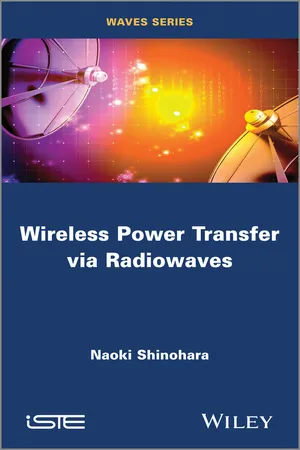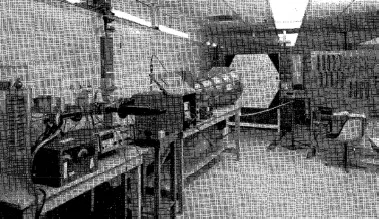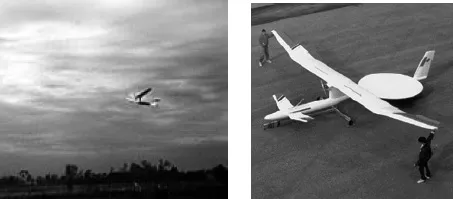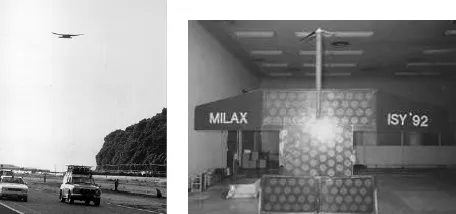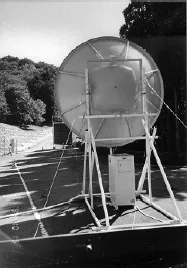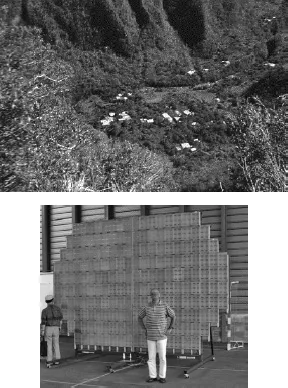![]()
Chapter 1
History, Present and Future of WPT
1.1. Theoretical predictions and the first trial in the 19th Century
In 1864, James C. Maxwell predicted the existence of radiowaves by means of a mathematical model. The so-called Maxwell equations are the most famous and most successful formulas. In 1884, John H. Poynting realized that the Poynting vector would play an important role in quantifying electromagnetic energy. In 1888, bolstered by Maxwell’s theory, Heinrich Hertz first succeeded in showing experimental evidence of radiowaves using his spark-gap radio transmitter. The prediction and evidence of radiowaves toward the end of the 19th Century was the beginning of wireless power transfer (WPT).
During the same period, when Marchese G. Marconi and Reginald Fessenden pioneered communication via radiowaves, Nicola Tesla suggested the idea of wireless power transfer and carried out the first WPT experiments in 1899 [TES 04a, TES 04b]. He said “This energy will be collected all over the globe preferably in small amounts, ranging from a fraction of one to a few horse-power. One of its chief uses will be the illumination of isolated homes”. Tesla actually built a gigantic coil that was connected to a 200 ft high mast with a 3 ft diameter ball at its top. The device was called the “Tesla Tower” (Figure 1.1). Tesla fed 300 kw of power to the coil that resonated at a frequency of 150 kHz. The radio frequency (RF) potential at the top sphere reached 100 MV. Unfortunately, the experiment failed because the transmitted power was diffused in all directions using 150 kHz radiowaves, whose wavelength was 21 km. After this first WPT trial, the history of radiowaves has been dominated by wireless communications and remote sensing.
Figure 1.1. The Tesla tower
1.2. Rejuvenated WPT by microwaves in the 1960s
To focus on the transmitted power and to increase the transfer efficiency, a higher frequency than that used by Tesla is required. In the 1930s, a great deal of progress in generating high-power microwaves in the 1–10 GHz range was achieved by the invention of the magnetron and the klystron. After World War II, high-power and high-efficiency microwave tubes were advanced by the development of radar technology. The power delivered to a receiver can be concentrated with microwaves. WPT using microwaves is called microwave power transfer (MPT).
On the basis of development of microwave tubes during World War II, W.C. Brown introduced the first MPT research and development in the 1960s. First, Brown developed a rectifying antenna, which he named a “rectenna” for receiving and rectifying microwaves. The efficiency of the first rectenna developed in 1963 was 50% at an output of 4 WDC and 40% at an output of 7 WDC, respectively [BRO 84]. With the rectenna, Brown successfully applied MPT to a wired helicopter in 1964 and to a free-flying helicopter in 1968 (Figure 1.2). In the 1970s, Brown attempted to increase the total DC–RF–transfer–RF–DC efficiency using 2.45 GHz microwaves. The overall DC–DC efficiency was only 26.5% at an output of 39 WDC in the Marshall Space Flight Center tests of 1970 [BRO 73a]. In 1975, the overall DC–DC efficiency finally attained 54% at an output of 495 WDC using the Raytheon Laboratory magnetron (Figure 1.3) [BRO 84]. In parallel, Brown, Richard Dickinson and his team succeeded in the largest MPT demonstration up to that time in 1975 at the Venus Site of the JPL Goldstone Facility (Figure 1.4). The distance between the transmitting parabolic antenna, whose diameter was 26 m, and a rectenna array, whose size was 3.4 m × 7.2 m, was 1 mile. The transmitted 2.388 GHz microwave signal was 450 kW from the klystron and the rectified DC power achieved was 30 kW DC with a 82.5% rectifying efficiency. On the basis of Brown’s work, P.E. Glaser proposed a solar power satellite (SPS) system in 1968 [GLA 68].
Figure 1.2. MPT Helicopter demonstration by W.C. Brown in 1964 [BRO 84]
Figure 1.3. MPT laboratory experiment by W.C. Brown in 1975 [BRO 84]
Figure 1.4. First ground-to-ground MPT experiment in 1975 at the Venus Site of the JPL Goldstone Facility
But after the MPT experiments of the 1960s, SPS applications have led the field in MPT research [MCS 02, MAT 02a]. Because of the theoretical calculation, the large antenna size required to achieve high-beam efficiency to a far distant target, an MPT system designed for SPS did not seem to be suitable for commercial applications. However, even if the antenna size was to become larger, there would be the other merits of the space-based SPS. The SPS is designed as a huge SPS in geostationary orbit, 36,000 km above the Earth’s surface, where there is no cloud cover and no night throughout the year. Microwave energy is not absorbed by air, cloud and rain; therefore, it is possible to obtain approximately 10 times the solar power, a stable and CO2-free energy source, from the SPS using MPT technology than that from terrestrial solar sources. As a result of the high benefits expected, MPT research mainly focused on SPS applications during the late 20th Century.
Numerous Japanese scientists developed MPT technologies and research throughout the 1980s [MAT 95a, MAT 02a]. In 1983 and 1993, Hiroshi Matsumoto’s team carried out the first MPT experiment in space. The rocket experiment in 1983 was called the microwave ionosphere nonlinear interaction experiment (MINIX) (Figure 1.5), and International Space Year – Microwave Energy Transmission in Space (ISY-METS) was conducted in 1993. These experiments focused on the nonlinear interaction between intense microwaves and ionospheric plasmas. In the MINIX experiment, the researchers used a cooker-type 800 W, 2.45 GHz magnetron for a microwave transmitter. New wave–particle interaction phenomena were observed during the MINIX study. Plasma theory and computer experiments supported the observations [MAT 95b, MAT 95c]. These rocket experiments were directed toward SPS applications.
Figure 1.5. The first rocket experiment by Matsumoto in Japan in 1983, called the MINIX project: a) image of mother and daughter rockets; b) image of the experiment
During the 1990s, numerous MPT laboratory and field experiments were carried out all over the world. This research was not only for SPS but also for other commercial MPT applications. Researchers often used 2.45 or 5.8 GHz frequencies of the industry, science and medical (ISM) band for MPT systems. A Canadian group of the Communication Research Centre (CRC) successfully conducted a fuel-free airplane flight experiment using MPT in 1987, which was called stationary high-altitude relay platform (SHARP) (Figure 1.6) [SCH 88, SHA 88]. They transmitted a 2.45 GHz, 10 kW microwave signal to a model airplane, having a total length of 2.9 m and a wing span of 4.5 m, flying more than 150 m above ground level. In the United States, a great deal of MPT research and development continued after Brown. For instance, retrodirective microwave transmitters, rectennas, new devices and microwave circuit technologies were investigated [BRO 88]. In Japan, several field MPT experiments were conducted, such as fuel-free airplane flight experiments with MPT phased arrays operating at 2.411 GHz for the microwave lifted airplane experiment (MILAX) project in 1992 (Figure 1.7) [MAT 93], ground-to-ground MPT experiments operating at 2.45 GHz were conducted by power companies and universities in 1994–1995 (Figure 1.8) [SHI 98a], and fuel-free light airship experiments using MPT operating at 2.45 GHz in 1995 [KAY 96]. The target system used in the MILAX project was the Japanese SHARP. Kobe University and Communications Research Laboratory (CRL; present National Institute of Information and Communications Technology (NICT)) group in Japan succeeded in an MPT field experiment involving a flying airship in 1995. They called it the Energy Transmission toward High-altitude long endurance airship Experiment (ETHER) project. This research group transmitted 2.45 GHz, 10 kW microwaves to a flying airship 35–45 m above ground level. In these experiments, except in those of the MILAX project, researchers adopted a parabolic antenna MPT system using a microwave tube. A phased array system was used only in the MILAX project, and this project was the first MPT field experiment to use it. In parallel with developments in Japan, varieties of microwave transmitters, retrodirective microwave transmitters and, especially, rectennas were also developed. In Europe, some unique technologies are presently being developed. Researchers had planned ground-to-ground MPT experiments on Réunion Island (Figure 1.9) [CEL 97, CEL 04], but the project has not yet been carried out.
Figure 1.6. The Canadian SHARP flight experiment and the 1/8 model airplane in 1987 [SHA 88]
Figure 1.7. The MILAX project airplane experiment showing the model airplane and the phased array used in Japan in 1992
Figure 1.8. Ground-to-ground MPT experiment in Japan in 1994–1995
Figure 1.9. Grand bassin, Réunion, France and their prototype rectenna [CEL 04]
1.3. Inductive coupling WPT projects in the 20th Century
Maxwell integrated Ampere’s law and Faraday’s law into his equations. Prior to Maxwell’s equations, it was known from Ampere’s Law and Faraday’s Law that a current creates a magnetic field and a changing magnetic field recreates a current. Two conductors are referred to as mutual-inductively coupled or magnetically coupled when they are configured such that a change in the current flow through one conductor induces a voltage across the ends of the other via electromagnetic induction. The phenomenon is called inductive coupling...
